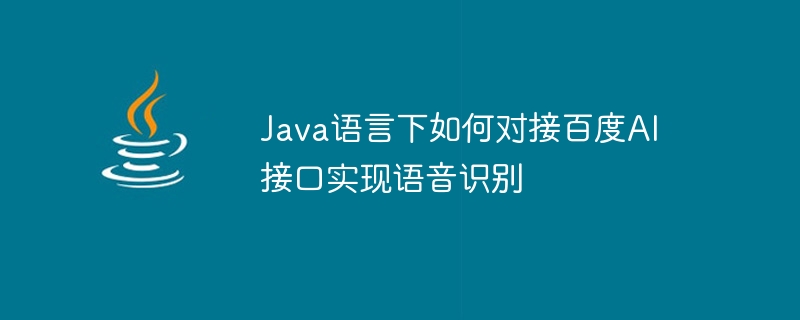Home >Java >javaTutorial >How to connect Baidu AI interface to achieve speech recognition in Java language
How to connect Baidu AI interface to achieve speech recognition in Java language
- 王林Original
- 2023-08-25 17:00:511460browse

How to connect Baidu AI interface to achieve speech recognition in Java language
1. Introduction
With the continuous development of artificial intelligence technology, speech recognition as An important part of them has been widely used in various fields. Baidu AI provides a series of powerful speech recognition API interfaces that can help developers implement various speech-related functions. This article will introduce how to use Java language to connect to Baidu AI interface to realize speech recognition function.
2. Preparation
Before we start, we need to prepare the following materials:
- Baidu AI Open Platform Account: Go to Baidu AI Open Platform to register an account , and create a new application, obtain the API Key and Secret Key.
- JDK environment: Ensure that the Java development environment has been installed and the environment variables are correctly configured.
- Baidu AI Java SDK: We will use the Java SDK provided by Baidu AI to simplify the API calling process. Go to Baidu AI Open Platform to download the Java SDK, and install and configure it according to the documentation provided.
3. Sample code
Next, we will use a simple Java program example to implement the speech recognition function.
import com.baidu.aip.speech.AipSpeech;
import org.json.JSONObject;
public class SpeechRecognition {
// 设置APPID/AK/SK
public static final String APP_ID = "你的APP ID";
public static final String API_KEY = "你的API Key";
public static final String SECRET_KEY = "你的Secret Key";
public static void main(String[] args) {
// 初始化一个AipSpeech
AipSpeech client = new AipSpeech(APP_ID, API_KEY, SECRET_KEY);
// 设置可选参数
HashMap<String, Object> options = new HashMap<String, Object>();
options.put("dev_pid", 1537); // 设置语音识别的语言类型,默认为普通话
// 读取音频文件
byte[] data = readAudioFile("test.wav");
// 调用语音识别接口
JSONObject res = client.asr(data, "wav", 16000, options);
// 打印识别结果
System.out.println(res.toString(2));
}
// 读取音频文件
public static byte[] readAudioFile(String filePath) {
File file = new File(filePath);
ByteArrayOutputStream out = null;
try {
AudioInputStream ais = AudioSystem.getAudioInputStream(file);
AudioFormat format = ais.getFormat();
out = new ByteArrayOutputStream();
byte[] buffer = new byte[1024];
int len;
while ((len = ais.read(buffer)) != -1) {
out.write(buffer, 0, len);
}
} catch (Exception e) {
e.printStackTrace();
}
return out.toByteArray();
}
} Please note that the above code needs to replace APP_ID, API_KEY and SECRET_KEY with your own information, and make sure test The .wav file exists. The method of reading audio files can be implemented using AudioInputStream and AudioFormat provided by Java.
4. Running results
After running the program, we will get a recognition result in JSON format and print it on the console. You can further process and utilize the results according to your own needs.
5. Summary
This article introduces the method of using Java language to connect Baidu AI interface to achieve speech recognition, and provides a simple sample code. By calling the API interface provided by Baidu AI, we can easily implement various voice-related functions and applications. I hope this article can help everyone in their development work in speech recognition.
The above is the detailed content of How to connect Baidu AI interface to achieve speech recognition in Java language. For more information, please follow other related articles on the PHP Chinese website!
Related articles
See more- Organize and share five puzzles about Java language expressions
- Introduction to WeChat applet development in Java language
- Use Python to connect with Tencent Cloud interface to implement speech recognition function
- Golang builds an intelligent recommendation system: using Baidu AI interface to implement product recommendations

